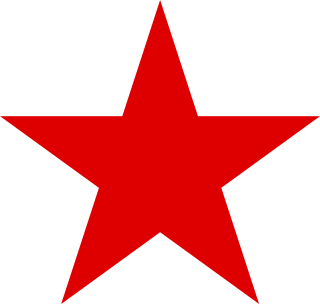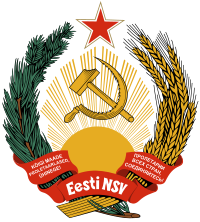
The flag of the Estonian Soviet Socialist Republic was officially adopted by the former Soviet Union in 1940. It showed a set of communist symbols: a yellow hammer and sickle on a red field and, after official change of the flag's design in 1953, also an outlined yellow star, above a band of water waves near the bottom.

The State Flag of the Union of Soviet Socialist Republics, also simply known as the Soviet flag or the Red Banner, was a red flag with two communist symbols displayed in the canton: a gold hammer and sickle topped off by a red five-point star bordered in gold. The flag's design and symbolism are derived from several sources, but emerged during the Russian Revolution. It has also come to serve as the standard symbol representing communism as a whole, recognized as such in international circles, even after the dissolution of the Soviet Union in 1991.

The hammer and sickle is a communist symbol representing proletarian solidarity between agricultural and industrial workers. It was first adopted during the Russian Revolution at the end of World War I, the hammer representing workers and the sickle representing the peasants.

A red star, five-pointed and filled, is a symbol that has often historically been associated with communist ideology, particularly in combination with the hammer and sickle, but is also used as a purely socialist symbol in the 21st century. It has been widely used in flags, state emblems, monuments, ornaments, and logos.

The coat of arms of the Republic of Estonia is a golden shield which includes a picture of three left-facing blue lions with red tongues in the middle, with golden oak branches placed on both sides of the shield. The coat of armes was derived from the 13th century royal coat of arms of Denmark, as the Duchy of Estonia (1219–1346) in what now northern Estonia was part of Denmark at the time.

The coat of arms of Russia derives from the earlier coat of arms of the Russian Empire. Though modified more than once since the reign of Ivan III (1462–1505), the current coat of arms is directly derived from its medieval original, with the double-headed eagle having Byzantine and earlier antecedents. The general tincture corresponds to the fifteenth-century standard.

The emblems of the constituent republics of the Union of Soviet Socialist Republics all featured predominantly the hammer and sickle and the red star that symbolized communism, as well as a rising sun, surrounded by a wreath of wheat. The USSR State motto, Workers of the world, unite!, in both the republic's language and Russian was also placed on each one of them. In addition to those repetitive motifs, emblems of many Soviet republics also included features that were characteristic of their local landscapes, economies or cultures.

The emblem of the Azerbaijan Soviet Socialist Republic was adopted in 1937 by the government of the Azerbaijan Soviet Socialist Republic. The style is based on the emblem of the Soviet Union.

The Byelorussian SSR emblem was used as the coat of arms of the Soviet Socialist Republic until the fall of the Soviet Union. The coat of arms is based on the coat of arms of the Soviet Union.

The coat of arms of the Kazakh Soviet Socialist Republic was adopted on 26 March 1937 by the government of the Kazakh Soviet Socialist Republic. The coat of arms is based on the coat of arms of the Soviet Union.

The emblem of the Kirghiz Soviet Socialist Republic was adopted on 23 March 1937 by the government of the Kirghiz Soviet Socialist Republic. The coat of arms is based on the coat of arms of the Soviet Union. It shows symbols of agriculture on a backdrop of the Ala-Too mountain ranges, surrounded by a frame of folk art of the Kyrgyz people. The red star was added in 1948. The rising sun stands for the future of the Kyrgyz nation, the star as well as the hammer and sickle for the victory of communism and the "worldwide socialist community of states".

The State Emblem of the Tajik Soviet Socialist Republic was adopted on 1 March 1937 by the government of the Tajik Soviet Socialist Republic. The emblem is based on the State Emblem of the Soviet Union. It shows symbols of agriculture. The red star is prominently featured with a small hammer and sickle within it. The rising sun stands for the future of the Tajik nation, and the star as well as the hammer and sickle for the victory of communism and the "world-wide socialist community of states". The emblem was replaced with the new emblem in 1992, which uses a similar design to the Soviet one. It was, however, was replacing the red banner with the current national flag, the big red star was replaced by the mountains, represents Pamir, the Samanid dynasty crown, and added the Quran book at below. It represents Islam as the official religion.

The Emblem of the Latvian Soviet Socialist Republic was adopted on August 25, 1940, by the government of the Latvian SSR. It was based on the emblem of the Soviet Union. It features symbols of agriculture (wheat) and Latvia's maritime culture. The red star as well as the hammer and sickle for the victory of communism and the "world-wide socialist community of states".

The Emblem of the Lithuanian Soviet Socialist Republic was adopted in 1940 by the government of the Lithuanian Soviet Socialist Republic. The emblem was designed by Vsevolodas Dobužinskis based on the State Emblem of the Soviet Union. The new coat of arms replaced the traditional coat of arms of Lithuania, known as Vytis, which was restored when Lithuania declared its independence in 1990.

The coat of arms of the Moldavian Soviet Socialist Republic was adopted on 10 February 1941 by the government of the Moldavian Soviet Socialist Republic. The coat of arms is based on the coat of arms of the Soviet Union. It shows symbols of agriculture, an outer rim featuring wheat, corn, grapes and clover. The red banner bears the Soviet Union state motto in both the Romanian language and the Russian language. In Romanian, it was initially "Пролетарь дин тоате цэриле, униць-вэ!"; then, from the 1950s "Пролетарь дин тоате цэриле, уници-вэ!". Both are written in the Latin alphabet as "Proletari din toate țările, uniți-vă!". The acronym MSSR is shown only in Romanian in Moldovan Cyrillic ("РССМ"). The emblem was replaced on 3 November 1990 by the present coat of arms of Moldova. Currently, the unrecognized breakaway state of Transnistria uses a similar state emblem.

The emblem of the Karelo-Finnish Soviet Socialist Republic was adopted on February 10, 1941 by the government of the Karelo-Finnish Soviet Socialist Republic and used until it was absorbed into the Russian Soviet Federative Socialist Republic in 1956.

Socialist-style emblems usually follow a unique style consisting of communist symbolism. Although commonly referred to as coats of arms, most are not actually traditional heraldic achievements. Many communist governments purposely diverged from heraldic tradition in order to distance themselves from the monarchies that they usually replaced, with coats of arms being seen as symbols of the monarchs.

The State Emblem of the Soviet Union was the official symbol of the Union of Soviet Socialist Republics adopted in 1923 and used until the dissolution of the state in 1991. Although it technically is an emblem rather than a coat of arms, since it does not follow traditional heraldic rules, in Russian it is called герб, the word used for a traditional coat of arms.
Communist symbolism represents a variety of themes, including revolution, the proletariat, the peasantry, agriculture, or international solidarity. The red flag, the hammer and sickle and the red star or variations thereof are some of the symbols adopted by communist movements, governments, and parties worldwide.

The 1940 Constitution of Estonian Soviet Socialist Republic was unanimously adopted by the "2nd People's State Assembly", a puppet legislature in the then Soviet-occupied Estonia, on 25 August 1940.




















